Pariah Nexus Battles
Books
| Book | Kind | Edition | Version | Last update |
 Pariah Nexus Mission Deck Pariah Nexus Mission Deck | ||||
 Pariah Nexus Mission Deck Pariah Nexus Mission Deck | Expansion | 10 | 1.4 | December 2024 |
FAQ
| Q: | If my unit starts an Action in my turn that completes at the end of my opponent’s next turn, can I target that unit with the Fire Overwatch Stratagem in my opponent’s turn without causing that Action to fail? |
| A: | Yes. |
| Q: | When scoring the Overwhelming Force Secondary Mission, how do I calculate the VP I gain for destroying one or more units within an Attached unit? |
| A: | If that Attached unit started the turn within range of an objective marker, you score VP for each unit within that unit you destroyed this turn. For example, if you destroyed both the Leader and Bodyguard units in that Attached unit, you would score 5VP (3VP x 2, capped at 5VP). |
| Q: | If a unit that is part of an Attached unit is destroyed, and that Attached unit was performing an Action, can the remaining unit(s) in that Attached unit still complete that Action? |
| A: | Yes. |
| Q: | If my opponent selects an Attached unit for the Marked for Death Secondary Mission, which units forming that Attached unit must I destroy to score VP? |
| A: | To score VP, you must destroy the Bodyguard unit and at least one of the Leader units that was attached to it. For example, if your opponent selects a unit of Boyz led by a Warboss and a Weirdboy, and you destroy that Boyz unit so that the Warboss and Weirdboy each become individual units, you must also destroy either that Warboss or that Weirdboy (or one of them must be removed from the battlefield for any other reason) to score VP from Marked for Death. |
| Q: | When selecting units for the Marked for Death Secondary Mission, can I select a Leader within an Attached unit? |
| A: | No. |
| Q: | When performing the Terraform Action, can I terraform an objective marker my opponent has already terraformed? |
| A: | No. |
| Q: | When do I resolve mission rules, such as Supply Drop, which happen at the start of the battle? |
| A: | Just after the Determine First Turn step. |
| Q: | In the Burden of Trust Primary Mission, how many times can each player score VP for guarding an objective marker they control? |
| A: | The player going first can score VP for guarding an objective marker they control at the end of their opponent’s second, third, fourth and fifth turn. The player going second can score VP for guarding an objective marker they control at the end of their opponent’s third, fourth and fifth turn. |
| Q: | When setting up objective markers as part of step 4 of the Pariah Nexus Tournament Mission Sequence, or setting up a new objective marker as part of a Primary Mission (such as The Ritual), do I measure from/to the centre or the edge of the objective marker? |
| A: | In all of these instances, you measure from the centre of the objective marker. This also includes the central objective marker in the Search and Destroy deployment map when measuring the boundaries of the deployment zones. |
| Q: | If a unit includes some models that have an Objective Control characteristic of 0 and some models that have an Objective Control Characteristic of higher than 0, does that prevent it from starting to perform an Action? |
| A: | No. |
| Q: | To start performing the Sabotage Action, does it require both the terrain feature and your unit to not be within your deployment zone? Or is it just your unit that must not be within your deployment zone? |
| A: | Only your unit must not be within your deployment zone to start performing the Sabotage Action. |
| Q: | In Burden of Trust, can you guard objective markers in your own deployment zone? |
| A: | Yes. |
| Q: | If an Action states in its Units section that one unit can perform it, is it possible for multiple units to each be performing one instance of that Action? |
| A: | No, only one unit from an army can be performing that Action at any one time. |
| Q: | For Primary and Secondary Missions that award VP for destroying CHARACTER models or units, if those models or units are returned to the battlefield and then subsequently destroyed again, will such Primary and Secondary Missions award VP for them being destroyed again? |
| A: | Yes, unless that Primary or Secondary Mission specifies otherwise. |
| Q: | For the purposes of the Mission Pack, are there any amendments to the Core Rules regarding how Ruins affect charging units and which models can fight? |
| A: | No. This means models can be positioned to make it difficult to charge directly through sections of terrain features into combat, as models can’t end their Charge move where any part of their model or base would be within sections of those terrain features (e.g. a solid Ruins wall). This may mean the result of a Charge roll needs to be greater to allow a unit to make a Charge move that ends within Engagement Range and not within any sections of those terrain features, while still following all other conditions of charging. Designer’s Note: Organisers, if your terrain collection includes large enclosed structures that units would be able to move within, but may render ending a Charge move within Engagement Range of those units within that terrain impossible, you may wish to include additional clarification for your particular terrain elements within your event packs to avoid uninteractive situations. |
Pariah Nexus Battles
A Pariah Nexus Chapter Approved battle is waged by following the sequence below. Chapter Approved battles are designed for Incursion and Strike Force battle sizes.
Muster Armies
Muster armies as described in the Core Rules.Determine Mission
Shuffle the Deployment, Mission Rule and Primary Mission decks, then draw one card from each of those decks for both players to use during the battle.Instead of shuffling and drawing from the Deployment, Mission Rule and Primary Mission decks, players should use the pre-generated missions from the Pariah Nexus Tournament Mission Pool. Set aside the Secondary Mission and Secret Mission decks as normal (players will receive these later).
Read Mission
Read the Primary Mission and Mission Rule cards drawn. The Primary Mission card details how and when you score Victory points (VP), and may also apply additional conditions to the battle. You can also score VP by achieving Secondary Missions and Secret Missions (described later). The Mission Rule card details any special rules that apply to the battle.Place Objective Markers
Set up objective markers on the battlefield, as shown on the Deployment card drawn.Players now set up objective markers on the battlefield. Each Deployment card’s deployment map will show players how many objective markers to set up and where each should be placed. In Pariah Nexus Tournament Missions, models can end any type of move on top of an objective marker.
Create The Battlefield
Create the battlefield and set up terrain features (see the Core Rules). Missions are played on rectangular battlefields 44" by 60" in size. Terrain features should not be set up within any impassable sections (such as the walls of a ruin) within 1" of any objective markers.Players now create the battlefield and set up terrain features. Missions are played on rectangular battlefields whose dimensions are approximately 44" by 60". When setting up terrain features, use the guidelines detailed in the Terrain Layouts section of this pack. Players must use the rules for terrain features detailed in the Core Rules. While other approaches to terrain layout may work within the collections of experienced organisers, we recommend these terrain guidelines when otherwise in doubt.
Determine Attacker and Defender
Look at the Deployment card drawn and agree which edges of your battlefield are the Attacker’s and Defender’s battlefield edges. Roll off: the winner decides who will be the Attacker and who will be the Defender.Select Secondary Missions
Secondary Mission cards detail additional ways to score VP, and must be used either as Fixed or Tactical Missions. Players now secretly note down whether they will use Fixed or Tactical Missions; if using Fixed Missions, they must also note down which two Fixed Missions they will use (see below). Players then reveal these decisions and proceed accordingly.Fixed Missions are those marked with the symbol shown on the left. After revealing the two Fixed Missions you will use, set aside the remainder of your Secondary Mission deck (it will not be needed during the battle). Your selected Fixed Mission cards cannot be discarded for any reason other than the Adapt or Die Mission Rule card.
After revealing that you will use Tactical Missions, shuffle your Secondary Mission deck.
If you are using Tactical Missions:
- At the start of your first Command phase, draw two cards from your Secondary Mission deck; those two Secondary Mission cards are active for you until you achieve them. At the start of each of your subsequent Command phases, if you have fewer than two active Secondary Mission cards, draw from your Secondary Mission deck until you have two active Secondary Mission cards.
- At the end of your Command phase, you can spend CP to use the New Orders Stratagem below.
TARGET: One of your active Secondary Mission cards.
EFFECT: Discard it and draw one new Secondary Mission card.
- At the end of either player’s turn, if you scored any VP this turn as described on a Secondary Mission card, discard that Secondary Mission card – it is achieved.
- At the end of your turn, you can discard one or more of your active Secondary Mission cards. If you do, you gain 1CP.
- If your Secondary Mission deck runs out, you cannot generate any additional Secondary Missions during the battle.
Declare Battle Formations
Players secretly note down which of their Leader units will start the battle attached to which Bodyguard units, which of their units will start the battle embarked within which TRANSPORTS, and which of their units will start the battle in Reserves (including Strategic Reserves). Players then reveal these decisions.- No more than half of the units in your army can start the battle in Reserves, and the points total of those units cannot be more than half of the points total of your army (units embarked within a TRANSPORT that is set up in Reserves also count towards these limits).
- Reserves units cannot arrive on the battlefield during the first battle round (excluding units placed into Strategic Reserves during the battle).
- Any Reserves units that have not arrived on the battlefield by the end of the third battle round count as having been destroyed, as do any units embarked within them (excluding units placed into Strategic Reserves during the battle).
Deploy Armies
Players take it in turns to set up their remaining units one at a time, starting with the Defender. A player’s models must be set up wholly within their deployment zone. If a player sets up a TITANIC unit when it is their turn to set up a unit, they skip their next turn to set up a unit. If one player finishes deploying all of their units, their opponent then deploys the remainder of their units.Redeploy Units
Some rules allow players to redeploy certain units after both armies are deployed. Unless otherwise stated, such rules are resolved in this step. Players alternate resolving any such rules, starting with the Attacker.Determine First Turn
Roll off: the winner takes the first turn.Resolve Pre-battle Rules
Players alternate resolving any pre-battle rules units from their army may have, starting with the player who will take the first turn.Begin the Battle
The first battle round begins. Players continue to resolve battle rounds until the battle ends.End the Battle
The battle ends after five battle rounds have been completed. Even if one player has no models remaining in their army at the start of their turn, players continue to play out their turns until the battle ends.Determine Victor
At the end of the battle, the player with the most VP is the winner. If the players are tied, the battle is a draw. The maximum VP each player can score is 100VP. Each player scores 10VP if their army is painted to a Battle Ready standard. The maximum VP that can be scored from each source of VP is detailed on below. In all cases, any excess VP awarded above these maximums are lost.
| ||||||||||||
Designer’s Notes
Deployment Card Key





|
|

Actions
Your forces can attempt daring battlefield tasks to turn the conflict in your favour.Some cards feature Actions that certain units can perform. Each Action states which units can perform it, when it is started and completed, and what the effects of completing it are.
A unit cannot start to perform an Action if one or more of the following apply to that unit:
- It is an AIRCRAFT unit.
- It is Battle-shocked.
- It has an Objective Control characteristic of 0.
- It is within Engagement Range of one or more enemy units (unless it is a TITANIC CHARACTER unit).
- It Advanced or Fell Back this turn.
- It is not eligible to shoot this phase (including units that have already been selected to shoot this phase).
If a unit starts to perform an Action, until the end of the turn, that unit is not eligible to shoot or declare a charge, unless it is a TITANIC CHARACTER unit, in which case, until the end of the turn, that unit cannot start to perform another Action and is not eligible to declare a charge.
If a unit performing an Action makes a move (excluding Pile-in and Consolidation moves) or leaves the battlefield, that Action cannot be completed.
Secret Missions
Secret Missions are challenging covert goals you can pursue if the Primary Mission seems in jeopardy.At the end of the third battle round, starting with the player who had the second turn, if your Primary Mission VP total is less than or equal to your opponent’s, you can choose to undertake a Secret Mission. If you do:
- Secretly select one card from your Secret Mission deck and place it to one side, face-down.
- In the fifth battle round, you cannot score any VP from the Primary Mission card.
- You cannot score more than 20VP from the Primary Mission card; any excess VP awarded above this maximum are lost.
- At the end of the battle, reveal your Secret Mission card to your opponent. If you achieved the goal described on that card, you score VP as described on that card.
Battle Ready
Playing games of Warhammer is a shared experience that we all want to look and feel great. To reflect this, Pariah Nexus games reward you for having a fully painted ‘Battle Ready’ army. Here we explain what that means, and where to find achievable online tutorials and painting guides to get your army ready for action!
When you play a Pariah Nexus game, there are 10 victory points available if every model in your army is painted to a Battle Ready standard. Battle Ready means your models are fully painted with a detailed or textured base.
This is considered to be the minimum standard of miniature painting for a Pariah Nexus mission, as well as a guaranteed method of scoring some victory points before the dice even start rolling.
The Citadel Colour range includes all the paints and hobby supplies you’ll need to paint your miniatures quickly and efficiently, In fact, Contrast paints were created especially to help you get your armies Battle Ready in no time — just one coat of Contrast paint lays down both a base colour and a bit of shade — while Technical paints give you a textured base with one application. It’s never been easier to get your army ready for a tournament.
Pariah Nexus Tournament Companion
Introduction
Welcome to the Pariah Nexus Tournament Companion! The following guidelines are designed to support organisers of Warhammer 40,000 events in delivering a fine-tuned tournament experience using the Pariah Nexus Mission Deck. That product offers unprecedented scope for all kinds of matched play, and its many variables create a dizzying array of potential missions – thousands, in fact! Some of these are particularly well suited to the most hotly contested scenarios, and this pack provides suggestions for the best event configurations. We have also taken the opportunity to optimise certain Core Rules concepts for tournament play.This document provides a ready-made framework for levelling the playing field and getting games underway quickly, whether you are planning your first matched play event or have years of experience organising the largest and most acclaimed tournaments. Its recommendations will be followed in full at most Games Workshop matched play events, and are considered the official way to play Warhammer 40,000 in a tournament setting, but can be adapted to suit your own circumstances – the terrain layout advice is aimed primarily at newer organisers, for example, and those with large established terrain collections should feel free to interpret it accordingly.
The recommendations are presented as follows:
- Pariah Nexus Tournament Mission Sequence: Adjustments to the steps players would normally follow to generate a mission and prepare the battlefield.
- Pariah Nexus Mission Deck Errata & FAQ: Updates to certain cards and answers to frequently asked questions (these tweaks are already included below, in the Mission Generator).
- Pariah Nexus Tournament Mission Pool: 20 recommended tournament rounds to draw from, with pre-set Primary Missions, Mission Rules and deployment modes that put all players on an equal footing and minimise pre-game admin.
- Terrain Layouts: A suite of carefully designed terrain setups to be used in conjunction with the Pariah Nexus Tournament Mission Pool.
- Pairings and Rankings: Advice for fairly pairing players and determining rankings.
Pariah Nexus Tournament Mission Pool
The 20 Pariah Nexus Tournament Missions in this section are designed to act as a pool from which organisers can build their events, selecting from it in random order. Further commentary on these is given below.
Every Primary Mission from the Pariah Nexus Mission Deck is included in this mission pool. If you are running an event with only 3-6 rounds, we recommend selecting options that span a variety of different Primary Missions. For example, if running a 3-round Saturday tournament, you might use missions B, I, and M, or C, K, and O.
For those running longer-format events, or whose attendees are particularly expectant of a perfectly balanced mission every time, we have included the more straightforward Primary Missions in a greater number of configurations.
Mission Rules are an exciting component of the Pariah Nexus Mission Deck, providing twists to the way a mission is normally played, and the ones recommended here are particularly suited to tournament play.
When using the recommended terrain layouts in this pack, please note the layouts best suited for each deployment mode, as shown in the table below. We recommend structuring your mission order to facilitate any changes to terrain layouts you will need to make during your event, if, as the organiser, you choose to set up the tables for the players.
| ||||||||||||||||||||||||||||||||||||||||||||||||||||||||||||||||||||||||||||||||||||||||||||||||||||||||||||||
Terrain Layouts
The following battlefield recommendations are intended primarily for newer organisers and those looking for a steer in building up a terrain collection for regular tournament play. These layouts will be seen at most Games Workshop matched play events, and reflect the type of terrain density that creates risk-and-reward decisions that a wide variety of army types can engage with. They are by no means the only way to set up a battlefield for balanced play, but represent a reliable starting point when in doubt.
They are by no means the only way to set up a battlefield for balanced play, but represent a reliable starting point when in doubt. These layouts were designed with a few key principles in mind:
Recommended Measurements
For all of the battlefield recommendations we use a combination of three different sizes of area terrain outlines:
|
Using the area terrain outlines detailed above, all of the battlefield recommendations have preset measurements provided. This allows for organisers to easily set up the tables, or allow the players themselves to set up their own tables at the beginning of each round.
Objective Markers
Objective markers can and sometimes will be either hidden within terrain or placed in the open.Use of Ruins
The following layouts primarily use the Ruins terrain feature. This efficiently achieves a good amount of line-of-sight blockage and cover appropriate for balanced games, thanks to the natural abstraction of line of sight within the rules for Ruins. Remember that a variety of terrain heights not only adds to the immersive nature of the battlefield, but is also important for line of sight and rules such as Plunging Fire. For organisers and players with a more robust terrain collection (especially elements that block true line of sight), incorporating features such as Woods, Barricades and Hills into your chosen layouts is perfectly acceptable.
|
|
Below are examples of Ruins terrain placements within area terrain sections, as well as icons that denote if connected area terrain outlines are a single area terrain section or separate area terrain sections when determining line of sight.
These height and Ruin placement guidelines help provide a balanced tournament experience; as organisers you are free to adjust this to suit your terrain collection.
|
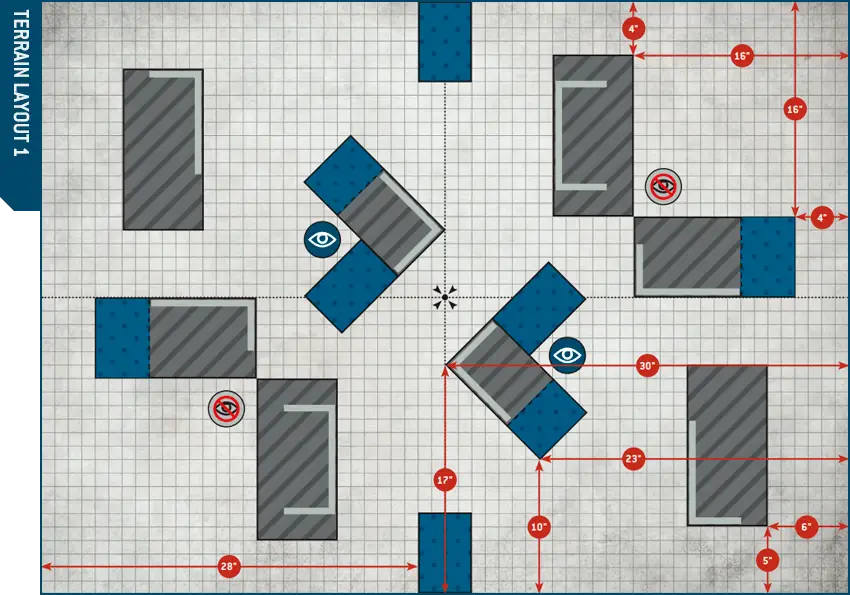
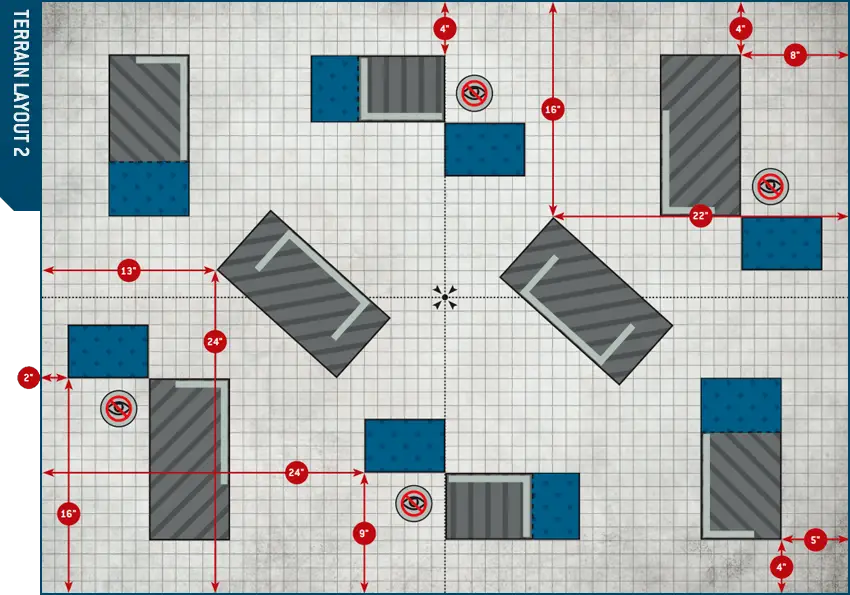
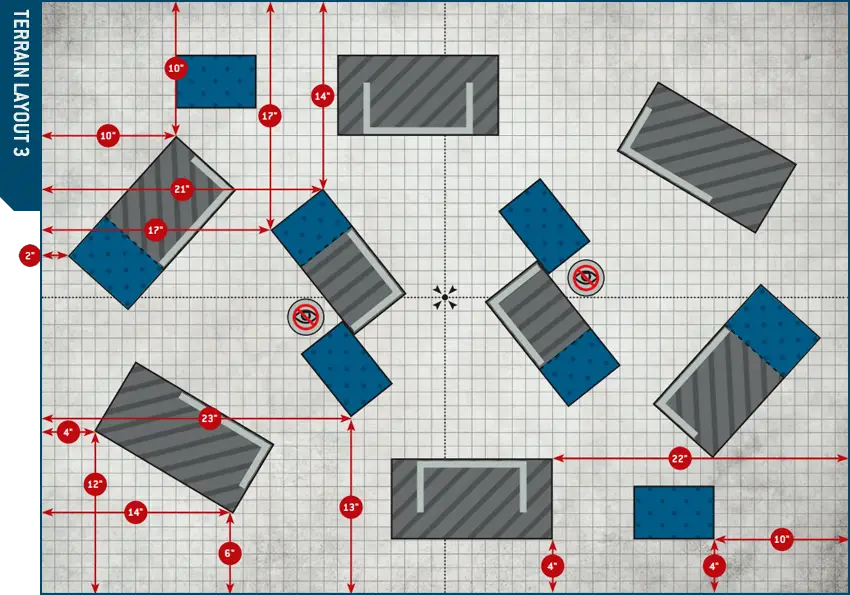
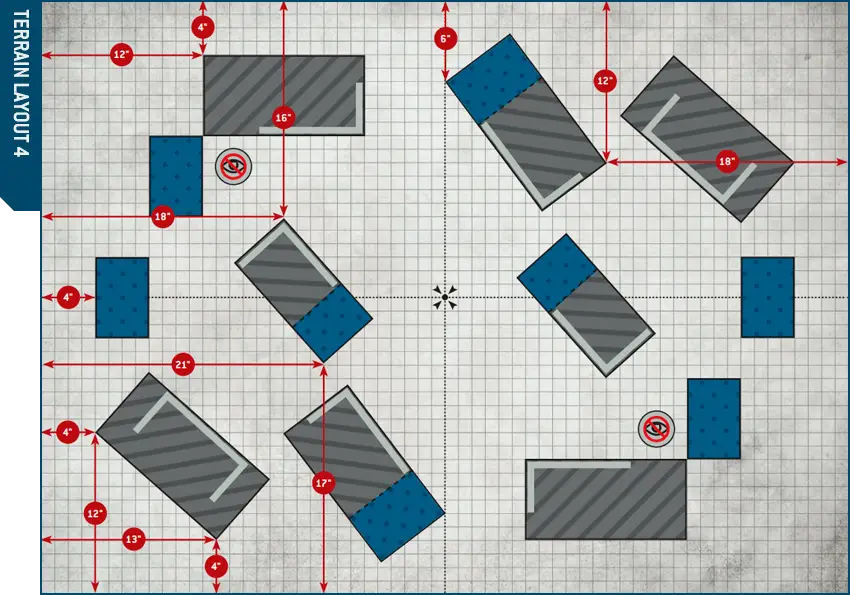
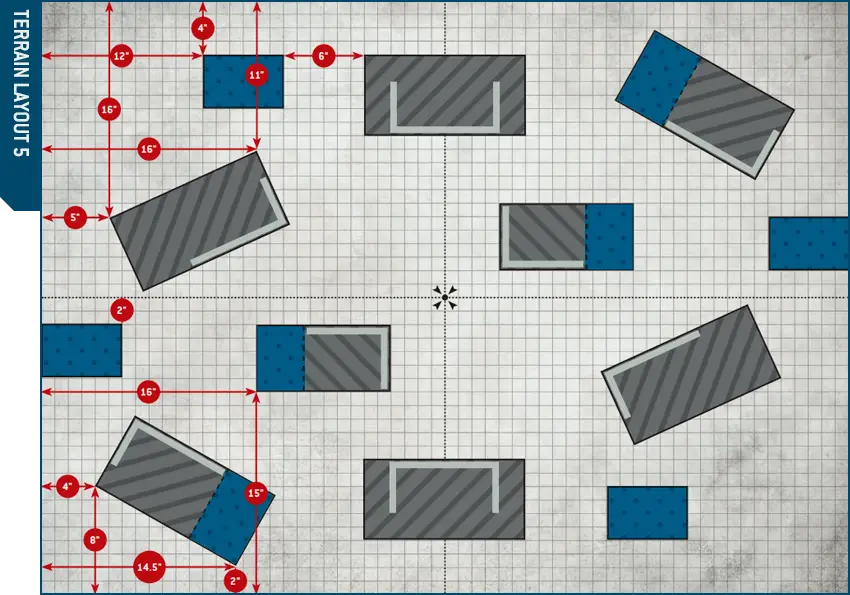
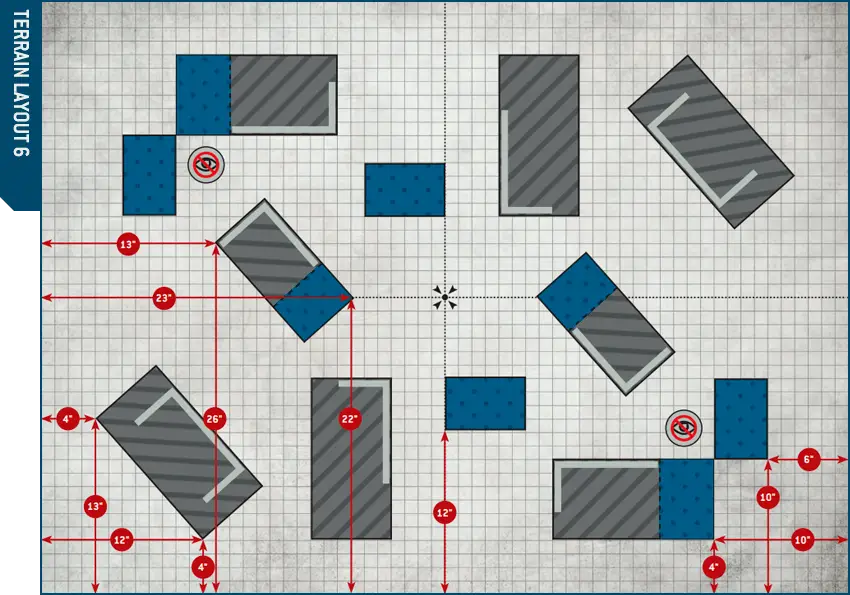
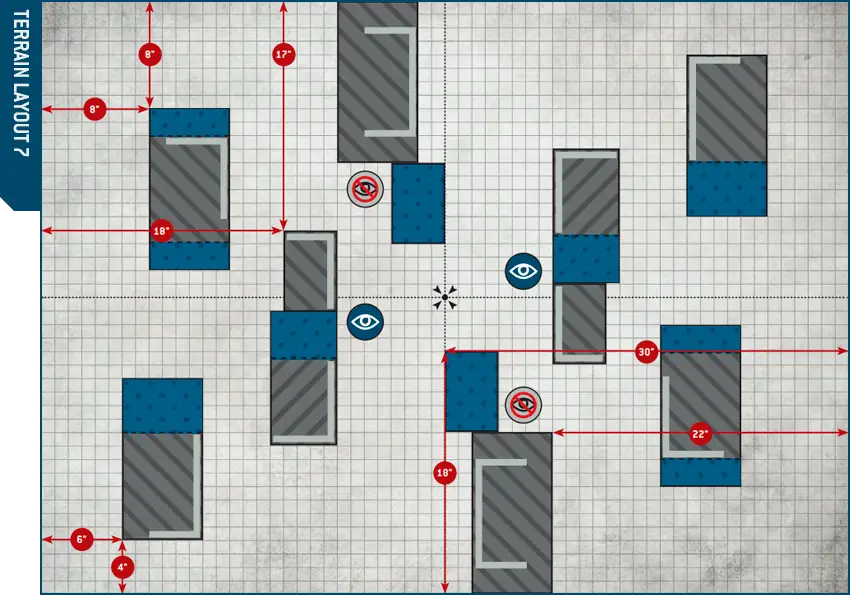
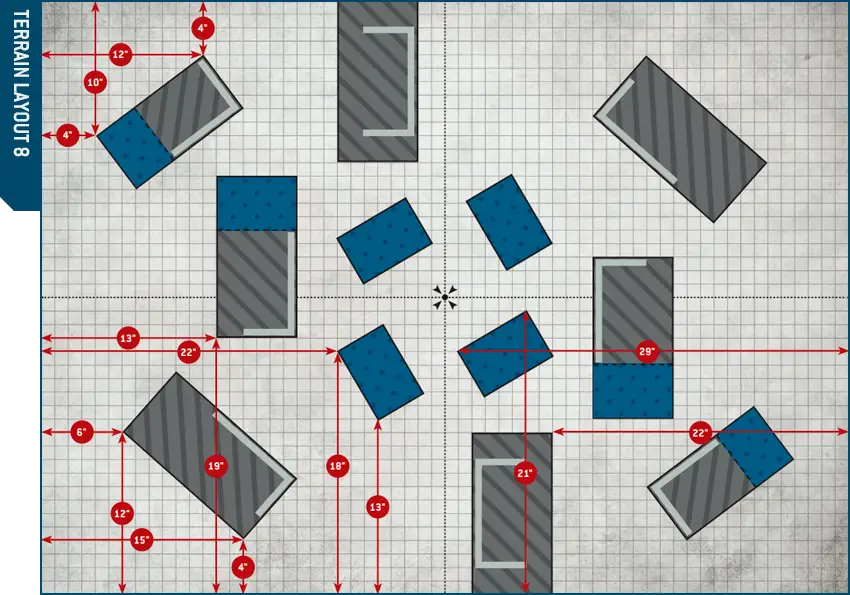
Pairings and Rankings
Pairing Players
While the first round of most tournaments is randomly paired, subsequent round pairing can be done in a number of ways. The first pairing metric will almost always be player record, i.e. pairing a 3-1 player with another 3-1 player, and so on. Given that most rounds will include numerous players with the same record, however, deciding pairings beyond this metric can be quite nuanced, and the different methods available can have significant impacts on the experience of players at an event. We recommend pairing players by the following criteria:- First – by record (i.e. the number of wins, losses and draws)
- Second – by win path (i.e. the timing of the rounds in which a player won or lost their games)
- Third – randomly within players of the same ranking
A player’s ‘win path’ refers not to their number of wins and losses, but to the timing of those wins and losses. While pairing by win path has an incidental tendency to pair people by strength of schedule, its greatest impact is on the overall enjoyment experienced by all players, as it tends to pair players based upon shared experience.
For example, let's take two 3-1 players. One of them lost their first game; they likely lowered their expectations for winning the whole event after this, but are probably in a great mood after three consecutive victories. The other won their first three games then lost their fourth – a sharp disappointment after a 3-0 start. Should these players face off, their shared enjoyment may be at odds as they are in very different emotional places. Win path ensures players enter their match with recent common experiences upon which to build a friendship during their next game of Warhammer.
Ranking Players
In many tournaments, the overall Best General will be the single remaining undefeated player at the end of the event. Sometimes, however, there are not enough rounds available to determine a single undefeated player, and players often wish to know their ranking regardless of whether they won the whole event. To help break ties between players who end an event with the same record, we recommend ranking players by the following criteria:- First – by overall record (wins, losses and draws)
- Second – by their opponents’ win records (i.e. those with more wins against opponents with better win records would place higher)
- Third – by total Victory points (VP)
As such, we do not recommend using VP as a pairing metric, nor as a ranking metric until all other metrics have been exhausted, or when further tie-breaking is required (e.g. in larger events where identical rankings become more likely). By contrast, opponent win record is an ideal metric, because when two players end up with the same record, the overall skill of their opponents is a better indicator of which player had the more challenging path along the way
There are myriad ways to enjoy the Warhammer hobby, and these all manifest themselves at a tournament: gifted hobbyists with beautiful armies, skilled competitors aiming for Best General, casual players looking to face new opponents and make new friends (by far the most common type of attendee), and even practitioners of the niche hobby of Rules Lawyer! These particular hobbyists often find unusual rules interactions at the very fringes of Warhammer 40,000, which can create interesting challenges for tournament organisers looking to provide clear answers and an easy gaming experience for their attendees. For the current edition, the Warhammer Design Studio has created its most robust and comprehensive Rules Commentary, Errata and FAQ to date. Available to download on warhammer-community.com, these living documents will be reviewed periodically to clarify any issues that may be causing uncertainty. Should an odd rules interaction come up during your event and the Core Rules do not provide a clear answer, we recommend consulting these resources.
Mission Generator
To use the mission generator, first press the ‘Start New Game’ button. This will "draw" a new set of Mission Rule, Primary Mission, and Deployment cards. You may also select any desired cards using dropdown lists if you play pre-generated missions from the Pariah Nexus Tournament Mission Pool. Note that ‘Start New Game’ and dropdown lists also reset the player’s Secondary and Secret Mission decks.
Next, choose whether you want to use Tactical or Fixed Secondary Missions using the slider. If you select Fixed, the cards available to you will appear below, and you can use the ‘Pick’ (
 ) and ‘Reject’ (
) and ‘Reject’ ( ) buttons to select two cards. Once you have your selection, click ‘Confirm’ to begin the game.
) buttons to select two cards. Once you have your selection, click ‘Confirm’ to begin the game.During the battle, if you use Tactical Missions, you can use the ‘Draw’ and ‘Discard’ (
 ) buttons to move through your Secondary Mission deck according to the mission rules. In the few cases where you might need to reshuffle a card back into the deck, a ‘Reshuffle’ button will appear. If you press this instead of the ‘Discard’ button, the card will still be available to draw later in the game.
) buttons to move through your Secondary Mission deck according to the mission rules. In the few cases where you might need to reshuffle a card back into the deck, a ‘Reshuffle’ button will appear. If you press this instead of the ‘Discard’ button, the card will still be available to draw later in the game.The generator processes the card as follows:
- If you have chosen Tactical Missions, then in acceptable cases the ‘Draw’ button with the number of remaining attempts becomes available (there are 2 in total). When you press that button, two cards are drawn. One of them must be returned to the deck using the ‘Reject’ button (
 ).
). - If you have chosen Fixed Missions, then the ‘Shuffle’ button (will appear above the cards. By pressing it, you send the specified card back to the deck. At the same time, the shuffle button will still be available for cards that specify the ‘When Drawn...’ condition. This is necessary if the victory conditions cannot be met in the game. Be careful and do not accidentally press this button again (Wahapedia can’t see what is happening on your table).
 )
)
Note that:
- If you accidentally close the browser or refresh the page your progress will be safe. It is saved on your device in the browser’s local storage.
- If you change the Mission Rule, Primary Mission, or Deployment cards, the generator will see it as a new game and reset the Secondary Mission and Secret Mission decks, losing all progress on your current game.
- It is not recommended to use this generator on multiple tabs of the same browser on the same device. It’s useless enough and also definitely will break the game.
Selected Secondary Missions
Attacker’s Selected Secondary Missions
Secondary Mission Deck
Attacker’s Secondary Mission Deck
Selected Secret Mission
Selected Attacker’s Secret Mission
Secret Mission Deck
Attacker’s Secret Mission deck
Defender’s Selected Secondary Missions
Defender’s Secondary Mission Deck
Selected Defender’s Secret Mission
Defender’s Secret Mission deck
Card Decks
Mission Rule deck
Few sights set such an inspiring example upon the battlefield than a commander leading from the verg front, wreathed in glory and stained with gore.
Armies hurl themselves recklessly into what is swiftly becoming a maelstrom of battle. With every passing moment, the flames of conflict rage higher.
The points total of the units a player can set up in this way cannot exceed 10% of their total points limit for the chosen battle size, as shown below.
|
Be it through technological trickery, sorcerous illusion or sheer cunning, both commanders seek to outfox and outmanoeuvre the other.
The points value of such a unit cannot exceed 25% of each player’s total points limit for the chosen battle size, as shown below.
|
Reconnaissance units have uncovered a hidden cache of ammunition, fuel and rations in this war zone.
In the Place Objective Markers step, players must set up one additional objective marker in No Man’s Land.
Before setting up this new objective marker, players must first move the objective marker in the centre of the battlefield 6" directly towards one of the corners of the battlefield (if No Man’s Land touches any of the corners of the battlefield, you must move the objective marker towards one of those corners). Otherwise, the players roll-off, and the winner selects which corner the objective marker is moved towards. Players then set up the new objective marker 6" from the centre of the battlefield towards the diagonally opposite corner of the battlefield to the previously moved objective marker.
It is not enough this day simply to defeat the foe. Instead you must raise your banners high, announcing your conquests to all who witness them.
This is not a time for gilded glory, but instead it is the hour when the mud-spattered, blood-drenched rank and file step forward and prove their worth.
On this changing battlefield, only a commander who can adapt their strategy swiftly and decisively stands any chance of seizing victory.
Time is running out. Cataclysm approaches on an unimaginable scale. In the face of such terrors, every warrior fights with the speed and fury of desperation.
Due to strange atmospheric conditions or supernatural phenomena, confusion abounds. Enemy positions are unknown, and you dare not commit your resources blindly.
This is a battle long in the offing, a fight for which both commanders have had ample time to prepare both their warriors and their defences.
Primary Mission deck
Exterminate the enemy. Show them no mercy.
Each player scores 4VP if one or more enemy units were destroyed this battle round.
Each player scores 4VP if more enemy units than friendly units were destroyed this battle round.
The player whose turn it is scores 4VP if they control one or more objective markers, and an additional 4VP if they control more objective markers than their opponent controls.
True victory is built upon a firm foundation. If the centre cannot hold then all else swiftly crumbles.
If the player whose turn it is does not control the objective marker in their deployment zone, they score 3VP for each objective marker they control.
What cannot be secured must be burned to ash.
UNITS: One unit from your army within range of an objective marker that is not within your deployment zone.
COMPLETES: End of your opponent’s next turn or the end of the battle (whichever comes first), if your unit is still within range of the same objective marker and you control that objective marker.
IF COMPLETED: That objective marker is burned and removed from the battlefield.
Each time a player burns an objective marker, that player scores 5VP if that objective marker was in No Man’s Land, or 10VP instead if that objective marker was in their opponent’s deployment zone.
The player whose turn it is scores 5VP for each objective marker they control (up to 10VP per turn).
Volatile undetonated material lies in your path. Shifting such hazards towards enemy territory could be the key to victory.
UNITS: One or more units from your army, each within range of a different Hazard objective marker you control.
COMPLETES: End of your turn, if the unit performing this Action is still within range of the same Hazard objective marker and you control that objective marker.
IF COMPLETED: You can move each of those Hazard objective markers up to 6". When doing so, that objective marker cannot end that move on top of any other objective marker or model, or inside impassable parts of terrain features.
The player whose turn it is scores VP as follows:
- 8VP for each Hazard objective marker that is wholly within their opponent’s deployment zone.
- 5VP for each other Hazard objective marker that is wholly within 6" of their opponent’s deployment zone.
- 2VP for each other Hazard objective marker that is wholly within 12" of their opponent’s deployment zone.
Supplies are inbound. Secure the drop coordinates.
Start of the Fourth Battle Round: The Alpha objective is removed from the battlefield.
Start of the Fifth Battle Round: All objective markers in No Man’s Land apart from the Omega objective are removed from the battlefield.
The player whose turn it is scores the following VP for each objective marker in No Man’s Land that they control, depending on the current battle round:
- 5VP in the second and third battle rounds.
- 8VP in the fourth battle round.
- 15VP in the fifth battle round.
Victory here lies in dominating not only the foe, but also the landscape of the battlefield itself.
UNITS: One or more units from your army, each within range of a different objective marker that is not within your deployment zone and has not been terraformed.
COMPLETES: End of your opponent’s next turn or the end of the battle (whichever comes first), if the unit performing this Action is still within range of the same objective marker and you control that objective marker.
IF COMPLETED: Each of those objective markers is terraformed.
The player whose turn it is scores VP as follows (up to 15VP per turn):
- 4VP for each objective marker they control.
- 2VP for each objective marker they have terraformed during the battle.
Note: The above VP are cumulative, so a player who controls one objective marker that they have also terraformed will score 6VP that turn.
The strategic prizes in this region must be guarded at all costs - a duty that falls upon a chosen few.
The player whose turn it is scores 4VP for each objective marker they control that is not within their deployment zone. Then, for each objective marker that player controls, they can select one unit from their army (excluding AIRCRAFT) within range of that objective marker to guard it until the start of their next turn.
The opponent of the player whose turn it is scores 2VP for each of their units (excluding Battle-shocked units) that are within range of and guarding an objective marker they control.
Several strategic locations have been identified in your vicinity. You are ordered to assault these positions, secure them and hold them at any cost.
The player whose turn it is scores 5VP for each objective marker they control (up to 15VP per turn).
Bitter foes clash in a race to finish a ritual to either sanctify or corrupt the battlefield.
UNITS: One unit from your army.
COMPLETES: End of your turn.
IF COMPLETED: Set up one objective marker anywhere on the battlefield wholly within No Man’s Land and within 1" of your unit, provided it can be setup exactly 12" from one other objective marker within No Man’s Land and not within 6" of any other objective marker.
The player whose turn it is scores 5VP for each objective marker in No Man’s Land that they control (up to 15VP per turn).
Deployment deck
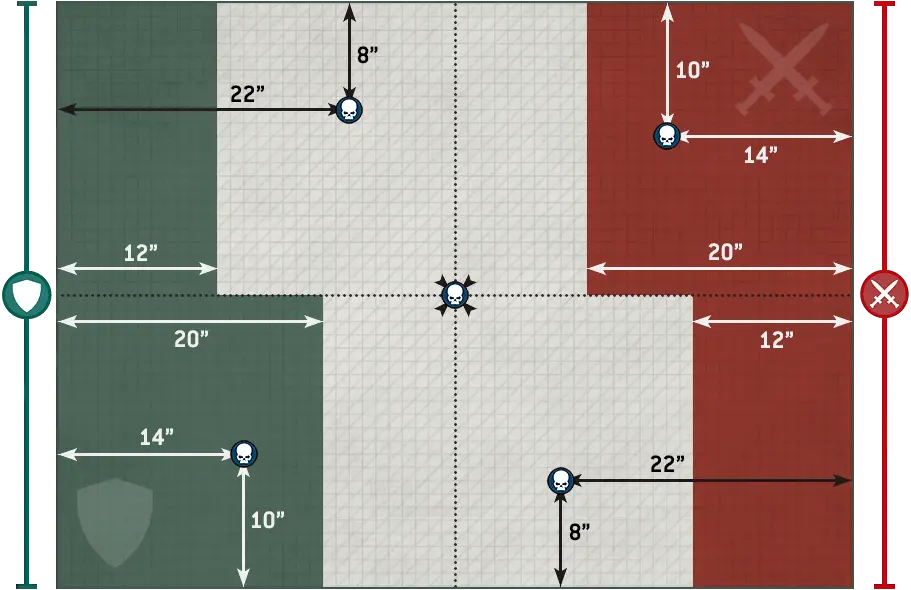
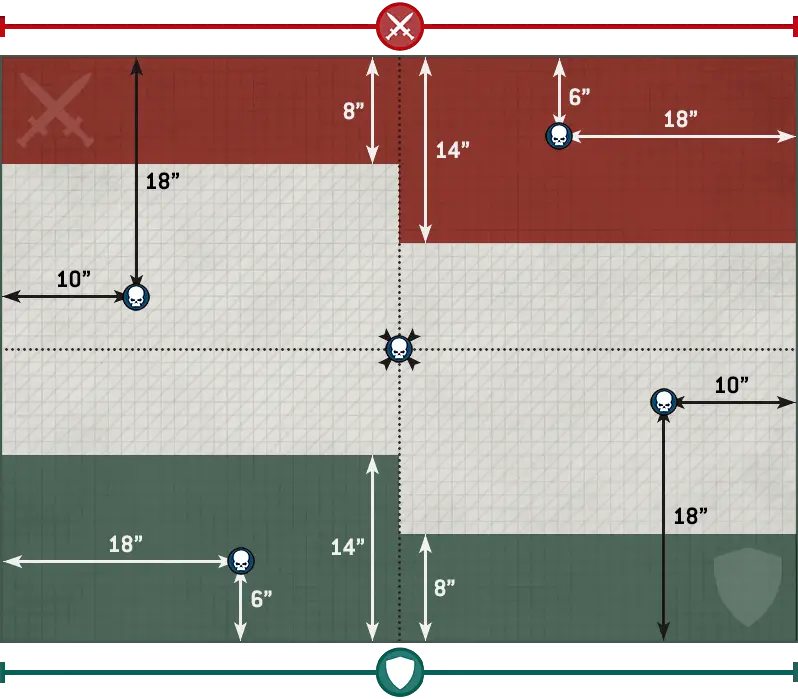
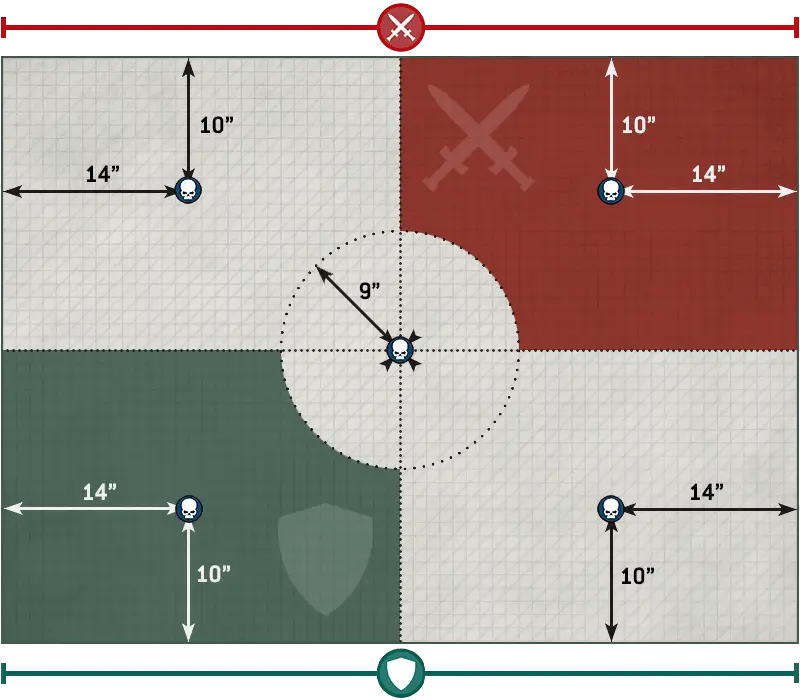
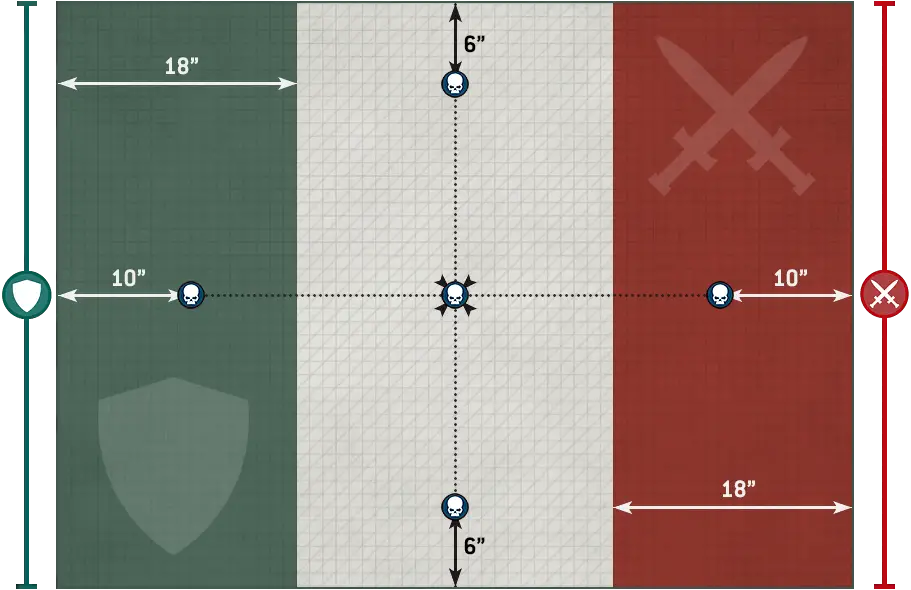
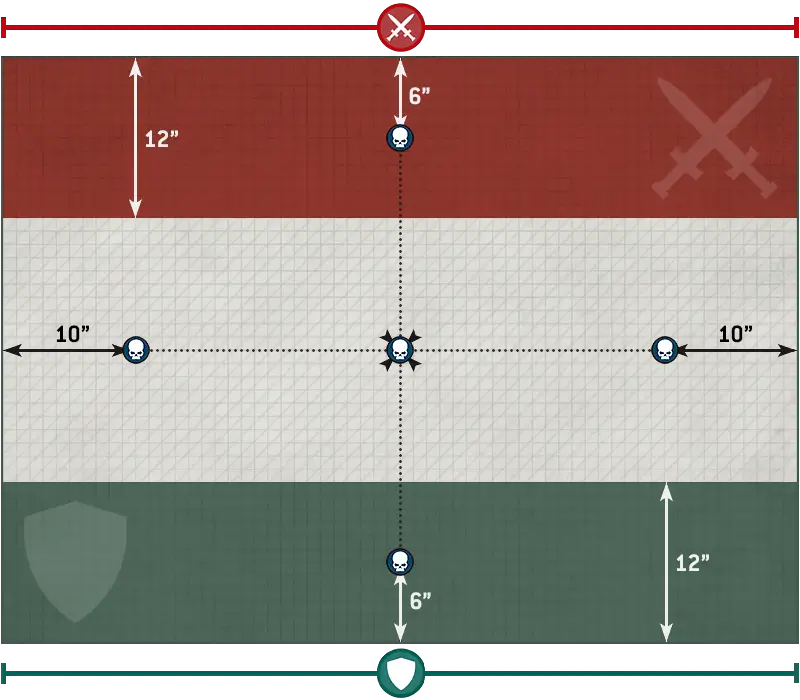
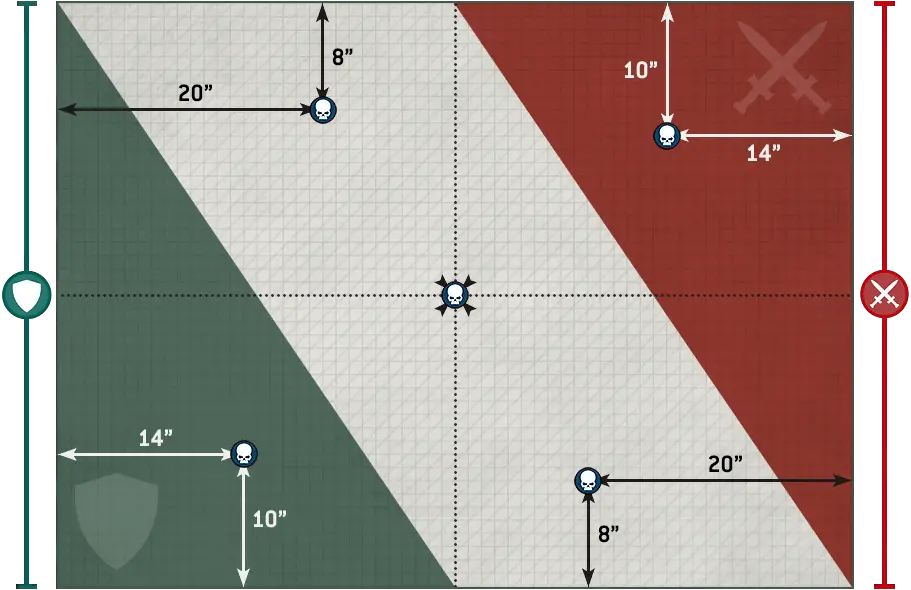
Secondary Mission deck
The enemy look to their champions for courage. Identify and eliminate them with extreme prejudice.
| |||||||||||||||||||||||||||||||||
Break through the foe’s army and cut off their lines of escape.
| |||||||||||||||||||||
The opposing army contains numerous heavily armoured units. Take any opportunity to bring them down.
| ||||||||||||||||||||||||
Dominate the field of battle. Storm every site of tactical import and leave the foe with no place to hide.
| |||||||||||||||||||||
The enemy come forth in teeming masses. Their ranks must be thinned if the day is to be won.
| ||||||||||||
Scattered strategic assets must be swiftly reclaimed.
|
| |||||||||||||||||||||
It is critical that this area is dominated. No enemy vanguard or guerrilla units can be allowed to disrupt our plans.
| |||||||||||||||||||||
You must advance swiftly into no man’s land and seize it before the enemy can, lest they take control of the entire battlefield.
| |||||||||||||||||||||
By setting up servo-sentries, laying booby traps or demolishing routes of egress, you must trap your foes within the bounds of this battlefield.
|
|
These specific enemy assets must be eliminated to ensure victory, no matter how insignificant they might seem.
|
Exterminate your enemies.
|
You are charged with the defence of a key objective. It must not be permitted to fall into enemy hands.
|
This region is replete with strategic assets or supply caches vital to the foe. See to it that they are reduced to just so much flaming wreckage.
|
| |||||||||||||||||||||
Scour the enemy from the face of the battlefield.
|
The battleground is conquered one yard at a time. Press forward to establish a strong military presence in the area.
| |||||||||||||||||||||
This area is of extreme importance. You are to lead an immediate all-out assault to capture it and deny it to our enemy for good.
| |||||||||||||||||||||
Whether a teleport homer crackling with arcane energies, a daemonic summoning circle, a pheromonal marker or some other means of guiding forces onto the battlefield, this locus must be set up swiftly to pave the road to victory.
|
| |||||||||||||||||||||
The objectives in this area have been tainted and must be cleansed with ritual and purifying flame.
|
| |||||||||||||||||||||
Secret Mission deck
Intelligence has revealed a secondary enemy attack incoming. Form a wall of warriors across this battlefield, ready to repel it.
|
There is no surer way to prevent your foe securing victory than to utterly destroy their strategic and tactical capabilities.
| |||||||||||||||||||||
Sometimes vital tasks cannot be entrusted to underlings. And such times, a commander must lead by example, bloodying their own hands to achieve victory.
|
This is to be a battle of numbers, wherein you must husband your core forces with skill while winnowing those of the foe.
|
- Normal Move: Models move up to M".
- Cannot move within Engagement Range of any enemy models.
- Advance Move: Models move up to M+D6".
- Cannot move within Engagement Range of any enemy models.
- Units that Advance cannot shoot or charge this turn.
A unit cannot shoot or declare a charge in the same turn that it Fell Back.
Desperate Escape Tests
Unlike when making other types of move, models can move over enemy models when making a Fall Back move as if those enemy models were not there, but you must take a Desperate Escape test for each model that will do so (excluding models that are TITANIC or can FLY) before any models in that unit are moved. In addition, if a unit is Battle-shocked when it is selected to Fall Back, you must take a Desperate Escape test for every model in that unit before any are moved.
- Fall Back Move: Models move up to M".
- Units that Fall Back cannot shoot or declare a charge in the same turn.
- Models can move over enemy models when Falling Back, but you must take Desperate Escape tests for them before they do so (excluding models that are TITANIC or can FLY).
- If a Battle-shocked unit is selected to Fall Back, take a Desperate Escape test for every model in that unit.
- Desperate Escape Test: Roll one D6. On a 1-2, one model from that unit is destroyed.
You then make a Charge roll for the charging unit by rolling 2D6. The result is the maximum number of inches each model in that unit can be moved if a Charge move is possible. For a Charge move to be possible, the Charge roll must be sufficient to enable the charging unit to end that move:
- Within Engagement Range of every unit that you selected as a target of the charge.
- Without moving within Engagement Range of any enemy units that were not a target of the charge.
- In Unit Coherency.
- Charge Roll: 2D6".
- Targets of a charge must be within 12" but do not need to be visible.
- If the distance rolled is insufficient to move within Engagement Range of all targets while maintaining Unit Coherency, the charge fails.
- Cannot move within Engagement Range of any unit that was not a target of the charge.
- If the charge is successful, each model makes a Charge move less than or equal to the Charge roll, and must move into base-to-base contact with an enemy model if possible.

An unmodified Hit roll of 6 is called a Critical Hit and is always successful. An unmodified Hit roll of 1 always fails. A Hit roll can never be modified by more than -1 or +1.
- Hit Roll (Ranged Attack): A hit is scored if the D6 result equals or exceeds that attack’s BS.
- Hit Roll (Melee Attack): A hit is scored if the D6 result equals or exceeds that attack’s WS.
- Critical Hit: Unmodified Hit roll of 6. Always successful.
- An unmodified Hit roll of 1 always fails.
- A Hit roll can never be modified by more than -1 or +1.
TARGET: One unit from your army that is within 24" of that enemy unit and that would be eligible to shoot if it were your Shooting phase.
EFFECT: If that enemy unit is visible to your unit, your unit can shoot that enemy unit as if it were your Shooting phase.
RESTRICTIONS: You cannot target a TITANIC unit with this Stratagem. Until the end of the phase, each time a model in your unit makes a ranged attack, an unmodified Hit roll of 6 is required to score a hit, irrespective of the attacking weapon’s Ballistic Skill or any modifiers. You can only use this Stratagem once per turn.
When setting objective markers up on the battlefield, place them so they are centred on the point specified by the mission. When measuring distances to and from objective markers, measure to and from the closest part of them. Models can move over objective markers as if they were not there, but they cannot end a move on top of an objective marker.
At the start of the battle, each objective marker on the battlefield is said to be contested, and so is not controlled by either player. To control an objective marker, a player will first need to move models within range of it. A model is within range of an objective marker if it is within 3" horizontally and 5" vertically of that objective marker.
Every model has an Objective Control (OC) characteristic listed on its datasheet. To determine a player’s Level of Control over an objective marker, add together the OC characteristics of all the models from that player’s army that are within range of that objective marker. A player will control an objective marker at the end of any phase or turn if their Level of Control over it is greater than their opponent’s. If both players have the same Level of Control over an objective marker, that objective marker is contested.
- A model is within range of an objective marker if within 3" horizontally and 5" vertically.
- Level of Control: Add together the OC characteristics of all of a player’s models within range of the objective marker.
- An objective marker is controlled by the player with the highest Level of Control over it (in a tie, it is contested).
- Models cannot end a move on top of an objective marker.
OVERWHELMING FORCE
Scour the enemy from the face of the battlefield.
|
The Starting Strength of an Attached unit is equal to the combined Starting Strengths of all of its units (i.e. the number of models in the Leader unit added to the number of models in the Bodyguard unit). If either the Leader unit or the Bodyguard unit in an Attached unit is destroyed, the Starting Strength of the remaining unit is changed to be equal to its original Starting Strength.
For the purposes of rules that are triggered when a unit is destroyed, such rules are still triggered when one of the individual units that made up an Attached unit is destroyed (the Leader or the Bodyguard unit).
MARKED FOR DEATH
These specific enemy assets must be eliminated to ensure victory, no matter how insignificant they might seem.
When Drawn: Your opponent must select three units from their army on the battlefield. If there are only one or two units from their army on the battlefield, they must select those units. If there are no units from their army on the battlefield, discard this card and draw a new Secondary Mission card.
|
TERRAFORM
Victory here lies in dominating not only the foe, but also the landscape of the battlefield itself.
UNITS: One or more units from your army, each within range of a different objective marker that is not within your deployment zone and has not been terraformed.
COMPLETES: End of your opponent’s next turn or the end of the battle (whichever comes first), if the unit performing this Action is still within range of the same objective marker and you control that objective marker.
IF COMPLETED: Each of those objective markers is terraformed.
The player whose turn it is scores VP as follows (up to 15VP per turn):
- 4VP for each objective marker they control.
- 2VP for each objective marker they have terraformed during the battle.
Note: The above VP are cumulative, so a player who controls one objective marker that they have also terraformed will score 6VP that turn.
SUPPLY DROP
Supplies are inbound. Secure the drop coordinates.
Start of the Battle: Players randomly select two different objective markers in No Man’s Land; the first selected is the Alpha objective, the second selected is the Omega objective.
Start of the Fourth Battle Round: The Alpha objective is removed from the battlefield.
Start of the Fifth Battle Round: All objective markers in No Man’s Land apart from the Omega objective are removed from the battlefield.
The player whose turn it is scores the following VP for each objective marker in No Man’s Land that they control, depending on the current battle round:
- 5VP in the second and third battle rounds.
- 8VP in the fourth battle round.
- 15VP in the fifth battle round.
While a unit is Battle-shocked:
- The Objective Control characteristic of all of its models is 0.
- If it Falls Back, you must take a Desperate Escape test for every model in that unit.
- Its controlling player cannot use Stratagems to affect that unit.
Once you have taken Battle-shock tests for all of your units that require them, your Command phase ends and you progress to your Movement phase.
In this step, if for any reason a unit is forced to take a Battle-shock test for being below its Starting Strength, unless otherwise stated, that unit does not also have to take a Battle-shock test for being Below Half-strength. While a unit is Battle-shocked, all models in that unit are also Battle-shocked.
- Take a Battle-shock test for each unit from your army on the battlefield that is Below Half-strength.
- Roll 2D6: if the result is greater than or equal to the unit’s Leadership, the test is passed. Otherwise, the unit is Battle-shocked until the start of your next Command phase.
- Battle-shocked units have an OC of 0 and their controlling player cannot use Stratagems to affect them.
- Battle-shocked units must take Desperate Escape tests if they Fall Back.
BURDEN OF TRUST
The strategic prizes in this region must be guarded at all costs - a duty that falls upon a chosen few.
The player whose turn it is scores 4VP for each objective marker they control that is not within their deployment zone. Then, for each objective marker that player controls, they can select one unit from their army (excluding AIRCRAFT) within range of that objective marker to guard it until the start of their next turn.
The opponent of the player whose turn it is scores 2VP for each of their units (excluding Battle-shocked units) that are within range of and guarding an objective marker they control.
THE RITUAL
Bitter foes clash in a race to finish a ritual to either sanctify or corrupt the battlefield.
When setting up the battlefield, remove all objective markers in No Man’s Land except the one closest to the centre of the battlefield.
UNITS: One unit from your army.
COMPLETES: End of your turn.
IF COMPLETED: Set up one objective marker anywhere on the battlefield wholly within No Man’s Land and within 1" of your unit, provided it can be setup exactly 12" from one other objective marker within No Man’s Land and not within 6" of any other objective marker.
The player whose turn it is scores 5VP for each objective marker in No Man’s Land that they control (up to 15VP per turn).
SEARCH AND DESTROY

SABOTAGE
This region is replete with strategic assets or supply caches vital to the foe. See to it that they are reduced to just so much flaming wreckage.
|
| |||||||||||||||||||||
Models cannot be set up or end a Normal, Advance or Fall Back move within Engagement Range of any enemy models. If for any reason a model cannot meet this condition, that model is destroyed.
- Engagement Range: Within 1" horizontally and 5" vertically.
- Models cannot be set up or end a Normal, Advance or Fall Back move within Engagement Range of any enemy models.
ADAPT OR DIE
On this changing battlefield, only a commander who can adapt their strategy swiftly and decisively stands any chance of seizing victory.
- A unit can embark within a friendly TRANSPORT if all of its models end a Normal, Advance or Fall Back move within 3" of that TRANSPORT.
- A unit cannot embark and disembark in the same phase.
Each time a model makes a Pile-in move, it must end that move closer to the closest enemy model. If it can also end that move in base-to-base contact with one or more enemy models while still satisfying all of the conditions above, it must do so. The controlling player chooses the order in which to move their models.
- Pile-in Move: Up to 3".
- Every model that moves must end closer to the closest enemy model, and in base-to-base contact with an enemy model if possible. The unit must end in Unit Coherency and within Engagement Range of at least one enemy unit (or no models can Pile In).
If a unit can end its Consolidation within Engagement Range of one or more enemy units, then each time one of its models makes a Consolidation move, it must end that move closer to the closest enemy model. If it can also end that move in base-to-base contact with one or more enemy models while still satisfying all of the conditions above, it must do so. The controlling player chooses the order in which to move their models.
- Consolidation Move: Up to 3".
- Every model that moves must end closer to the closest enemy model, and in base-to-base contact with an enemy model if possible. The unit must end in Unit Coherency and within Engagement Range of at least one enemy unit if possible.
- If the above is not possible, each model can move towards the closest objective marker, but this must result in the unit being within range of it and in Unit Coherency.
- If the above is also not possible, no models can Consolidate.
TAKE AND HOLD
Several strategic locations have been identified in your vicinity. You are ordered to assault these positions, secure them and hold them at any cost.
The player whose turn it is scores 5VP for each objective marker they control (up to 15VP per turn).
RAISE BANNERS
It is not enough this day simply to defeat the foe. Instead you must raise your banners high, announcing your conquests to all who witness them.
At the end of each player’s turn, if a BATTLELINE unit from their army is within range of an objective marker that player controls, that unit raises a banner on that objective marker: that player scores 1VP (which is counted towards their Secondary Mission score), and that player’s units can no longer raise a banner on that objective marker.
TIPPING POINT

Layout 1

Layout 2

Layout 4

Layout 6

Layout 7

Layout 8

PURGE THE FOE
Exterminate the enemy. Show them no mercy.
Each player scores 4VP if one or more enemy units were destroyed this battle round.
Each player scores 4VP if more enemy units than friendly units were destroyed this battle round.
The player whose turn it is scores 4VP if they control one or more objective markers, and an additional 4VP if they control more objective markers than their opponent controls.
SMOKE AND MIRRORS
Be it through technological trickery, sorcerous illusion or sheer cunning, both commanders seek to outfox and outmanoeuvre the other.
After both players have deployed their armies, starting with the Attacker, each player can place one unit from their army that is on the battlefield into Strategic Reserves, regardless of how many units are already in Strategic Reserves.
The points value of such a unit cannot exceed 25% of each player’s total points limit for the chosen battle size, as shown below.
|
LINCHPIN
True victory is built upon a firm foundation. If the centre cannot hold then all else swiftly crumbles.
If the player whose turn it is does not control the objective marker in their deployment zone, they score 3VP for each objective marker they control.
Shattered ruins and twisted wreckage afford much-needed shelter from enemy salvoes. Even heavily armoured warriors unfazed by small arms fire are thankful for such cover when foes bring their biggest guns to bear.
Models can sometimes gain a measure of protection from terrain features. The rules below detail the conditions under which a terrain feature confers the Benefit of Cover on a model.Each time a ranged attack is allocated to a model that has the Benefit of Cover, add 1 to the saving throw made for that attack (excluding invulnerable saving throws). Models with a Save characteristic of 3+ or better cannot have the Benefit of Cover against attacks with an Armour Penetration characteristic of 0. Multiple instances of the Benefit of Cover are not cumulative – a model cannot benefit from this rule more than once at any one time.
- Benefit of Cover: Add 1 to armour saving throws against ranged attacks.
- Does not apply to models with a Save of 3+ or better against attacks with an AP of 0.
- Multiple instances are not cumulative.
TARGET: One of your active Secondary Mission cards.
EFFECT: Discard it and draw one new Secondary Mission card.
FOG OF WAR
Due to strange atmospheric conditions or supernatural phenomena, confusion abounds. Enemy positions are unknown, and you dare not commit your resources blindly.
In the first battle round, units have the Benefit of Cover, and players cannot use Core Stratagems (excluding the New Orders Stratagem).
SCORCHED EARTH
What cannot be secured must be burned to ash.
UNITS: One unit from your army within range of an objective marker that is not within your deployment zone.
COMPLETES: End of your opponent’s next turn or the end of the battle (whichever comes first), if your unit is still within range of the same objective marker and you control that objective marker.
IF COMPLETED: That objective marker is burned and removed from the battlefield.
Each time a player burns an objective marker, that player scores 5VP if that objective marker was in No Man’s Land, or 10VP instead if that objective marker was in their opponent’s deployment zone.
The player whose turn it is scores 5VP for each objective marker they control (up to 10VP per turn).
SWIFT ACTION
Time is running out. Cataclysm approaches on an unimaginable scale. In the face of such terrors, every warrior fights with the speed and fury of desperation.
BATTLELINE units that Advance or Fall Back are still eligible to perform an Action in that turn.
Whether shielded by force fields, enveloped in mystical energies or simply possessed of preternatural senses and lightning-fast reflexes, some warriors are protected by more than mere physical armour.
Some models have an invulnerable save listed on their datasheet. Each time an attack is allocated to a model with an invulnerable save, the controlling player must choose to use either that model’s Save characteristic or its invulnerable save, but not both. If a model has more than one invulnerable save, it can only use one of them – choose which it will use.Unlike armour saving throws (which use a model’s Save characteristic), invulnerable saving throws are never modified by an attack’s Armour Penetration characteristic, but otherwise follow the normal rules for saving throws.
- Invulnerable Save: Never modified by an attack’s AP.
- The controlling player can choose to use either a model’s invulnerable save or its Save characteristic.
TARGET: One INFANTRY unit from your army that was selected as the target of one or more of the attacking unit’s attacks.
EFFECT: Until the end of the phase, all models in your unit have a 6+ invulnerable save and have the Benefit of Cover.
Many warriors thunder headlong into combat, using the impetus of their charge to bring swift death to their foes.
Each time a unit makes a Charge move, until the end of the turn, that unit has the Fights First ability.TARGET: One unit from your army that is within 6" of that enemy unit and would be eligible to declare a charge against that enemy unit if it were your Charge phase.
EFFECT: Your unit now declares a charge that targets only that enemy unit, and you resolve that charge as if it were your Charge phase.
RESTRICTIONS: You can only select a VEHICLE unit from your army if it is a WALKER. Note that even if this charge is successful, your unit does not receive any Charge bonus this turn.
PREPARED POSITIONS
This is a battle long in the offing, a fight for which both commanders have had ample time to prepare both their warriors and their defences.
Players can target their BATTLELINE units with the Go to Ground and Heroic Intervention Stratagems for 0CP (but cannot do so if they have already used that Stratagem on a different unit that turn).
HAMMER AND ANVIL

HIDDEN SUPPLIES
Reconnaissance units have uncovered a hidden cache of ammunition, fuel and rations in this war zone.
When Drawn: If you also drew The Ritual Primary Mission card, discard this Mission Rule card and draw a new Mission Rule card.
In the Place Objective Markers step, players must set up one additional objective marker in No Man’s Land.
Before setting up this new objective marker, players must first move the objective marker in the centre of the battlefield 6" directly towards one of the corners of the battlefield (if No Man’s Land touches any of the corners of the battlefield, you must move the objective marker towards one of those corners). Otherwise, the players roll-off, and the winner selects which corner the objective marker is moved towards. Players then set up the new objective marker 6" from the centre of the battlefield towards the diagonally opposite corner of the battlefield to the previously moved objective marker.
STALWARTS
This is not a time for gilded glory, but instead it is the hour when the mud-spattered, blood-drenched rank and file step forward and prove their worth.
BATTLELINE units that perform an Action are still eligible to shoot in that turn (but cannot start to perform another Action in that turn), and BATTLELINE units can perform Actions while within Engagement Range of one or more enemy units.
Layout 3

RAPID ESCALATION
Armies hurl themselves recklessly into what is swiftly becoming a maelstrom of battle. With every passing moment, the flames of conflict rage higher.
In the first battle round, each player can set up BATTLELINE units from Strategic Reserves in the Reinforcements step of their Movement phase. If they do, those units must be set up wholly within 6" of any battlefield edge, but no model in those units can be set up within the enemy deployment zone.
The points total of the units a player can set up in this way cannot exceed 10% of their total points limit for the chosen battle size, as shown below.
|
CRUCIBLE OF BATTLE

INSPIRED LEADERSHIP
Few sights set such an inspiring example upon the battlefield than a commander leading from the verg front, wreathed in glory and stained with gore.
While a player’s WARLORD is not within their deployment zone, each time a unit from that player’s army takes a Battle-shock test, if that player’s WARLORD is within 9" of and visible to that unit, add 1 to that test.
SWEEPING ENGAGEMENT

Layout 5

DAWN OF WAR

UNEXPLODED ORDNANCE
Volatile undetonated material lies in your path. Shifting such hazards towards enemy territory could be the key to victory.
The objective markers that start the battle in No Man’s Land are Hazard objective markers.
UNITS: One or more units from your army, each within range of a different Hazard objective marker you control.
COMPLETES: End of your turn, if the unit performing this Action is still within range of the same Hazard objective marker and you control that objective marker.
IF COMPLETED: You can move each of those Hazard objective markers up to 6". When doing so, that objective marker cannot end that move on top of any other objective marker or model, or inside impassable parts of terrain features.
The player whose turn it is scores VP as follows:
- 8VP for each Hazard objective marker that is wholly within their opponent’s deployment zone.
- 5VP for each other Hazard objective marker that is wholly within 6" of their opponent’s deployment zone.
- 2VP for each other Hazard objective marker that is wholly within 12" of their opponent’s deployment zone.
Mighty heroes fight at the forefront of battle.
Some CHARACTER units have ‘Leader’ listed on their datasheets. Such CHARACTER units are known as Leaders, and the units they can lead – known as their Bodyguard units – are listed on their datasheet.During the Declare Battle Formations step, for each Leader in your army, if your army also includes one or more of that Leader’s Bodyguard units, you can select one of those Bodyguard units. That Leader will then attach to that Bodyguard unit for the duration of the battle and is said to be leading that unit. Each Bodyguard unit can only have one Leader attached to it.
While a Bodyguard unit contains a Leader, it is known as an Attached unit and, with the exception of rules that are triggered when units are destroyed, it is treated as a single unit for all rules purposes. Each time an attack targets an Attached unit, until the attacking unit has resolved all of its attacks, you must use the Toughness characteristic of the Bodyguard models in that unit, even if a Leader in that unit has a different Toughness characteristic. Each time an attack sucessfully wounds an Attached unit, that attack cannot be allocated to a CHARACTER model in that unit, even if that CHARACTER model has lost one or more wounds or has already had attacks allocated to it this phase. As soon as the last Bodyguard model in an Attached unit has been destroyed, any attacks made against that unit that have yet to be allocated can then be allocated to CHARACTER models in that unit.
Each time the last model in a Bodyguard unit is destroyed, each CHARACTER unit that is part of that Attached unit is no longer part of an Attached unit. It becomes a separate unit, with its original Starting Strength. If this happens as the result of an attack, they become separate units after the attacking unit has resolved all of its attacks.
Each time the last model in a CHARACTER unit that is attached to a Bodyguard unit is destroyed and there is not another CHARACTER unit attached, that Attached unit’s Bodyguard unit is no longer part of an Attached unit. It becomes a separate unit, with its original Starting Strength. If this happens as the result of an attack, they become separate units after the attacking unit has resolved all of its attacks.
Each time a unit that is part of an Attached unit is destroyed, it does not have the keywords of any other units that make up that Attached unit (unless it has those keywords on its own datasheet) for the purposes of any rules that would be triggered when that unit is destroyed.
- Before the battle, CHARACTER units with the Leader ability can be attached to one of their Bodyguard units to form an Attached unit.
- Attached units can only contain one Leader.
- Attacks cannot be allocated to CHARACTER models in Attached units.
- If a unit has a Starting Strength of 1, then it is said to be Below Half-strength while its remaining number of wounds is less than half of its Wounds characteristic.
- For any other unit, while the number of models in that unit is less than half of its Starting Strength, that unit is said to be Below Half-strength.







